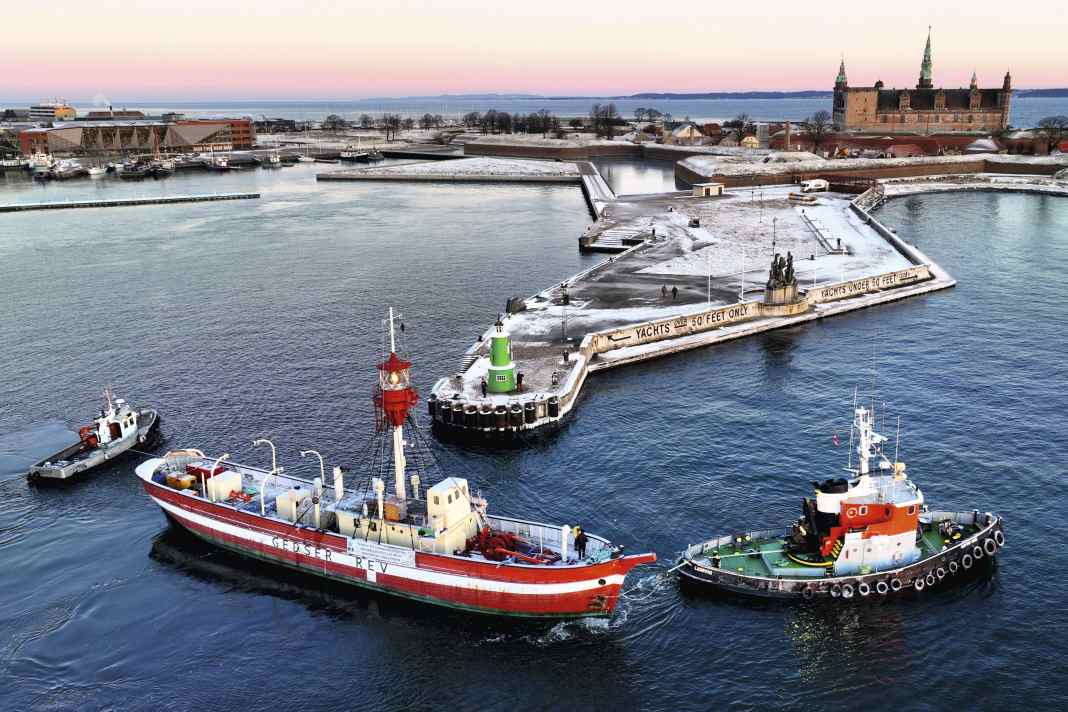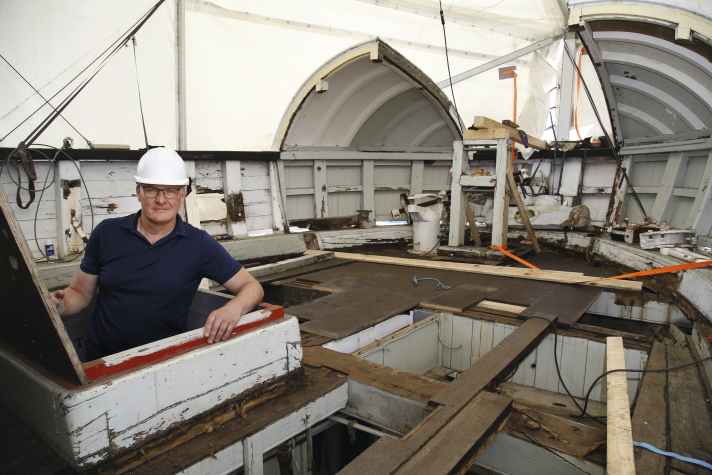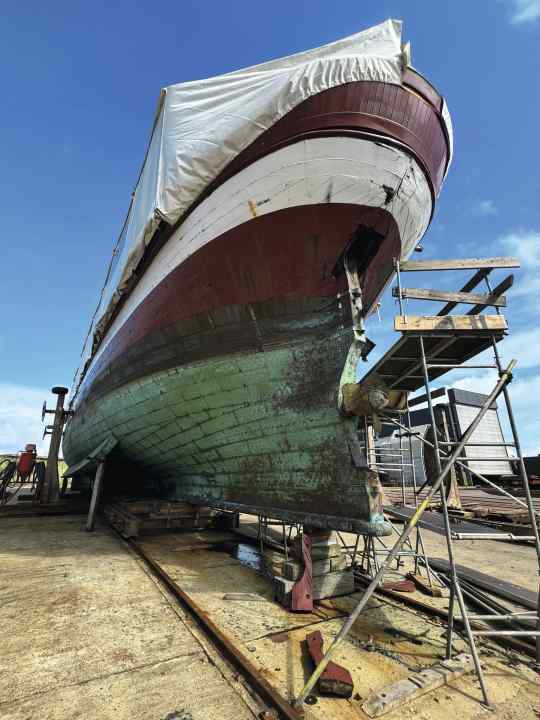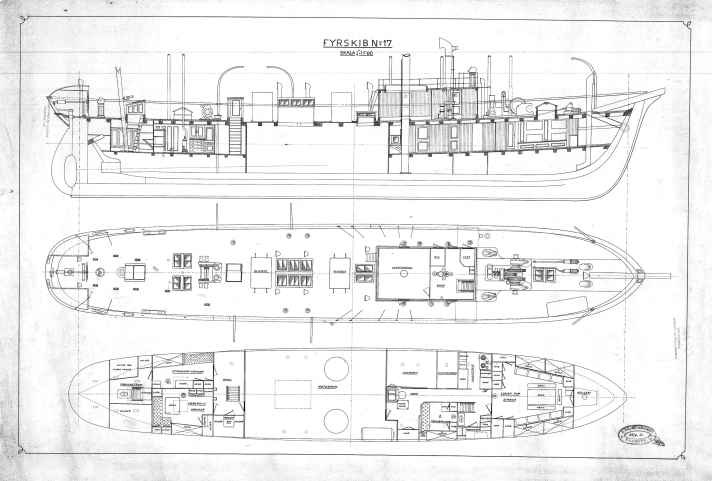





- Attraction in Hvide Sande
- Restoration of the "Gedser Rev" is hard work
- Espionage in the cadet channel
- The "Gedser Rev" was a glimmer of hope for GDR refugees
- Spectacular escapes and coded radio messages
- In 1954, the "Gedser Rev" is rammed and sinks
- Nyhavn in Copenhagen has long been home to the "Gedser Rev"
- The Öresund is the original hunting ground
- A piece of Danish maritime history
- Technical data "Gedser Rev"
It's a bitterly cold January morning in Helsingør, Denmark, almost exactly one year ago. A light blanket of snow lies over the harbour area, icicles hang from the pier. At first light, the lightship No. XVII "Gedser Rev" is towed out of the harbour to be sent on a 300 nautical mile journey to Hvide Sande. Despite the sub-zero temperatures, the timing is perfect: there is no wind and the forecast for the next few days is calm.
That's important, because the route is a tough one. From the Öresund, it first goes through the Kattegat, then around the tip of Denmark and finally across the Jammer Bay. This section of the North Sea coast of our neighbouring country has always been feared by sailors, with countless ships stranded here. However, the shorter and less exposed route through the Limfjord was not an option for the unusual tug and tow. Some parts of the inland route were silted up and the requirements for a transit licence were too high.
Attraction in Hvide Sande
So up around Skagen. Travelling at a maximum speed of five knots, the transfer of the maritime cultural asset takes around 60 hours. To be on the safe side, the historic lightship is equipped with emergency pumps. It reaches its destination undamaged. There, the floating navigation mark with the unmistakable red and white hull is already awaited by onlookers and shipyard employees.
Hvide Sande now has a new orientation aid for the duration of the restoration, as the light on the lighthouse shines continuously, even on land. However, it is not allowed to flash so as not to confuse shipping. The work is scheduled to take twelve months. If everything goes according to plan, the ship will start its journey home to Helsingør these days. There it will once again serve as a museum ship.
Restoration of the "Gedser Rev" is hard work
During a visit to the shipyard last summer, the "Gedser Rev" is a hive of activity. Project manager Jesper Vejlgaard gives a tour of the dry ship. "Penetrating rainwater is the biggest enemy of a wooden ship. Moisture and fungal infestation literally eat away at the wood from the inside," he says. The fresh water has found its way deep into the stern via the steering gear, where it has caused considerable damage over the years. Vejlgaard: "We are currently replacing some of the frames, which is really hard work due to the solid construction of the ship."
Penetrating rainwater is the biggest enemy of a wooden boat. Moisture and fungal infestation eat away at the boat from the inside."
To access the connecting bolts, the copper plates must first be removed. They should act as a protective shield against ice floes and also protect the hull from fouling and worms. Sections of the interior panelling, some floor cradles and iron reinforcements also have to be removed in order to access the red frames. Once they have been replaced, a large part of the restoration work is complete.
While a pot of pitch simmers away in front of the ship, new calfskin is being hammered into old plank seams on deck. The sharp "clang" of hammer blows on iron wedges echoes through the hull; it goes through the marrow and bone.

Espionage in the cadet channel
Below deck, time seems to have stood still. In the radio room, the disintegrating instructions for the on-board heating system lie on the table, looking as mysterious as an old treasure map - or a secret document. In fact, the lightship played an important role during the Cold War: the crew had to keep an eye out for Warsaw Pact ships. From 1945 to 1972, the "Gedser Rev" was stationed on the reef of the same name between the Danish island of Falster and the coast of the former GDR. Every ship that travelled the Kadet Channel from east to west was photographed and reported around the clock. These could be Russian landing craft, Polish submarines or even ordinary freighters.
Jesper Vejlgaard recounts that the crew also observed some of the cargo ships loaded with rocket technology on their way to the Caribbean. A little later, in October 1962, the Cuban Missile Crisis occurred, in which the world narrowly avoided nuclear war.
Inside the "Gedser Rev" you can see the traces of the decades
Times on the ship were not always that exciting. Everyday life consisted of routine - and a strict separation of crew grades. Vejlgaard: "The engine room was something of a boundary. The ordinary mortals lived forward, while the captain, officers and radio operators lived aft."
During the restoration, the quarters are cleaned to remove what has literally been swept under the carpet for many years. A musty-smelling layer of dust and dirt particles has settled between and under the floorboards. The drains to the bilge pumps are all blocked. The archaic-looking ship's diesel engine is still in working order. However, it spews out such black smoke "that the residents of Helsingør can no longer hang their washing out to dry," says Jesper Vejlgaard.
The red-painted three-cylinder Vølund diesel engine with 135 hp is rather weak in the face of a ship 35.50 metres long and weighing 350 tonnes. It and the propeller, which is also relatively small, were only designed to keep the ship in position in wind and weather, not to propel it forward. Stability in rough seas is ensured by two short wing keels that extend from the hull at an angle of 45 degrees on both sides.

The "Gedser Rev" was a glimmer of hope for GDR refugees
The crew of the "Gedser Rev" consisted of seven men. They were on duty for a fortnight at a time and were then relieved. It is hard to imagine today how monotonous life was on a ship permanently at anchor. The construction of the Berlin Wall in 1961 put an end to the monotony. Many GDR refugees chose the dangerous route across the Baltic Sea to reach freedom. And the "Gedser Rev" was only 20 nautical miles off the coast of Mecklenburg-Vorpommern at the time.
Thanks to her fire, she literally became a glimmer of hope for the people in the East - and for some of them, she was also a lifeline during their attempts to escape, usually in the dark of night. Until the lightship was decommissioned in 1972, the crew took in around 50 GDR citizens.
Jesper Vejlgaard also has exciting stories to tell about this. "Most of them ventured out in late summer, when the water temperatures were still bearable and the sheltering nights were getting longer again. They often paddled out in adventurous boats. However, many were picked up by the People's Navy before they had crossed the sea border. Others are still missing today." The lucky ones who make it on board the "Gedser Rev" can look forward to a cup of coffee and a warm shower.
Spectacular escapes and coded radio messages
Among them is a young man who introduces himself to the Danes with a strong Saxon accent: "Good morning, my name is Bernd Böttger and I come from Sebnitz near Dresden. May I come on board?" He escapes in September 1968 with the help of an aqua scooter that he developed and built himself. From Graal-Müritz, he sets a precise course underwater towards the red and white life raft anchored out there. Its crew is astonished, having never seen such a strange means of transport before. For his spectacular underwater escape, Böttger was proclaimed "Refugee of the Year 1968" in the West German press. His scooter would later go into series production.
With the coded radio message "We need water", the mail boat from Gedser is regularly informed that refugees who have been picked up need to be brought ashore. The pointed ears of the People's Navy were not supposed to hear anything. However, the activities of the lightship did not seem to remain completely hidden from the GDR border guards and secret service agents. A postcard of the "Gedser Rev" disappears from GDR sales outlets, as does the position of the lightship marked on the GDR's official nautical chart. Obviously, there was no desire to inspire citizens who wanted to escape.
In 1954, the "Gedser Rev" is rammed and sinks
The crew of the lightship need fear neither the border guards nor the passing ships of the class enemies from the east. Instead, the danger came from ships that were unable to manoeuvre or inattentive captains. The archives contain numerous documents reporting collisions with the lightship. Sometimes it is an English schooner, sometimes a Swedish galleass, sometimes a steamer from Esbjerg.
The most serious accident occurred in 1954 when the "Gedser Rev" was rammed on the port side. She sank and sank within a few minutes. The sailor on watch manages to alert the rest of the crew before he is thrown from the ship and drowns. Everyone else manages to save themselves. The ship itself is later raised and repaired.
Nyhavn in Copenhagen has long been home to the "Gedser Rev"
When it was decommissioned in 1972, it was initially stored at the Holmen naval station in Copenhagen. Following a donation from the container ship shipping company Maersk, it was purchased by the Danish National Museum to be displayed in Copenhagen's famous Nyhavn harbour for the next 42 years.
One day, guitar maker Jakob Bondo Schultz stumbles across discarded planks lying next to the "Gedser Rev" on the cobblestones of Nyhavn. The Bornholm native has a soft spot for historic ship timbers, which he uses to build customised instruments. He gratefully takes them back to his workshop in Svaneke. And as another coincidence would have it, an Australian musician discovers an interesting link to his family history in the vastness of the internet: his great-grandfather Jørgen Jensen was a ship's carpenter on the "Gedser Rev" from 1895 to 1915.
The man from the other side of the world is enthusiastic about the idea of obtaining an electric guitar from the planks of the lightship on which his Danish ancestor once lived and worked. The deal was struck and a year later he travelled to Copenhagen to receive his sonorous piece of family history on board the "Gedser Rev". The following spring, a small parcel from Down Under arrived in the guitar maker's letterbox. Inside was a CD called "Feuerschiff ", recorded with that very special guitar.
The Öresund is the original hunting ground
Since 2018, the lightship has been back in its original home territory, in Helsingør at the northern entrance to the Öresund. The number seventeen in the series of Danish lighthouse ships was launched in 1895 and was first used at Lappegrund, a sandbank one and a half nautical miles north-west of Helsingør. At that time, messages were still transmitted to the ship via the signal flag of the "Hamlet Castle" Kronborg, and below deck two steam engines drove the ship's propeller.
The crew also observed the weather for the Meteorological Institute and seabirds for the zoological museum."
In 1921, the Vølund engine was installed and the ship was moved to Gedser Reef, where it remained only interrupted by the war years until it was decommissioned. At the height of the lightship era, there were 25 of the floating lighthouses in Denmark, which were used between 1829 and 1980. Today, two are still in their original condition: In addition to the "Gedser Rev", it is the 19 years younger motor lightship no. 1 "Horns Rev", which can be visited in the North Sea harbour of Esbjerg. All the others have either been converted into restaurant and club ships or houseboats - or sent straight to the scrapper.
A piece of Danish maritime history
This makes the maintenance of the "Gedser Rev" all the more important to the Maritime Museum in Helsingør. Every day, volunteers help to preserve her condition. Shortly before Christmas, Jens Broch, who is responsible for the ship, comes to Hvide Sande to take delivery of his favourite project. "We can hardly wait until our ship returns to the harbour in Helsingør!"
The residents of the West Jutland harbour town must therefore bid farewell to the "Gedser Rev". But the chances of a reunion are not bad. The lightship was already here for restoration 20 years ago.
Broch also has a consolation: the disused oak frames from 1895 will be turned into memorabilia that will be sold in the museum. "In this way, we want to give enthusiasts of our ship the opportunity to take a piece of Danish maritime history home with them."
Technical data "Gedser Rev"

At the beginning of the 20th century, the lightship had a taller lighthouse with a shorter range, which was fuelled by paraffin. This was later replaced by a shorter steel tower, but with a longer range, and was electrically fuelled.
- Shipyard: N. F. Hansen, Odense
- Launching: 1895
- Decommissioning: 1972
- Material/construction: Oak panelling and copper plate
- Lighthouse height: 20 m
- Total length: 35,50 m
- Width: 6,59 m
- Depth: 3,36 m
- Weight: 350 t
- Machine: Three-cylinder Vølund

